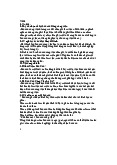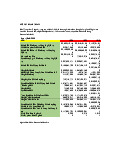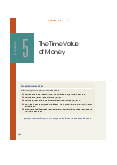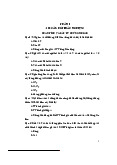



















Preview text:
CHƯƠNG 1: Question 1
C1. The ideal capital structure for a firm is the mixture of debt and equity that:
a. maximizes the value of the firm.
b. minimizes the annual interest expense.
c. equates the level of debt to the level of equity.
d. minimizes the long-term debt. Question 2
3. Which one of the following functions should be assigned to the controller, rather than the treasurer? a. Financial planning b. Cash management c. Tax planning d. Capital expenditure Question 3
2. Finance includes decisions related to a firm's:
a. capital expenditures, such as deciding when a supplier should be paid.
b. capital structure, such as determining the extent to which debt should be used to finance the firm's operations.
c. capital budgeting, such as determining the optimal level of inventory.
d. net working capital, such as determining the appropriate amount of long-term debt to
be acquired to finance a new capital project. Question 4
5. Which of the following correctly describes the balance sheet of a firm?
a. Current assets, fixed assets, and equity are on the left-hand side of the balance sheet.
Current liabilities and long-term liabilities are on the right-hand side.
b. Current assets, current liabilities, and equity are on the right-hand side of the balance
sheet. Fixed assets and long-term liabilities are on the left-hand side.
c. Current assets and current liabilities are on the right-hand side of the balance sheet.
Fixed assets, long-term liabilities, and equity are on the left-hand side.
d. Current assets and fixed assets are on the left-hand side of the balance sheet. Current
liabilities, fixed liabilities, and equity are on the right-hand side. Question 5
4. Companies can raise cash to finance their investment activities by:
a. buying back their financial instruments.
b. not producing goods during the current quarter. c. making dividend payments.
d. selling or issuing financial instruments. Question 1
C1. Which of the following is NOT a true statement concerning sole proprietorships?
a.vThe sole proprietor has limited liability for business debts.
b. The sole proprietorship is the cheapest to form.
c. The equity money that can be raised by the sole proprietor is limited to the proprietor's personal wealth.
d. The life of the sole proprietorship is limited to the life of the sole proprietor. Question 2
3. Secondary markets are defined as: a. (1) and (2) b. (3) being only OTC markets.
c. (1) either auction or dealers markets.
d. (2) Markets in which security are resold after they are originally issued. Question 3
4. In a ____________, none of the owners are offered the protection of limited liability. a. Sole proprietorship b. Limited liability company c. Corporation d. Limited partnership Question 4
5. Which of the following is the BEST description of the goal of the financial manager in
a corporation where shares are publicly traded? a. Avoid financial distress b. Maximize profits
c. Maximize the current value per share of the existing stock d. Maximize sales Question 5
2. Which of the following is NOT a true statement concerning corporations?
a. A corporation is a distinct legal entity.
b. The corporation has unlimited life.
c. Because ownership in a corporation is represented by shares of stock, ownership
cannot be readily transferable to new owners.
d. Perpetual succession is a major disadvantage of corporations. Question 1
Q13. Which form of business structure is most associated with agency problem? a. sole proprietoship b. corporation c. general partnership d. limited partnership Question 2
Q4 Shareholder A sold 500 shares of ABC stock on the HOSE. This transaction:
a. was facilitated in the secondary market b. was a private placement
c. took place in the primary market d. occurred in a dealer market Question 3
Q11. Decisions made by financial managers should primarily focus on increasing which one of the following?
a. market value per share of outstanding stock b. size of the firm c. total sales
d. gross profit per unit produced e. growth rate of the firm Question 4
Q1 Which one of the following terms is defined as the management of a firm's long - term investment? a. financial allocaiton b. working captital management c. capital budgeting d. capital structure Question 5
Q10. Which one of the following best states the primary goal of financial management?
a. maximize current dividents per share
b. minimize operational costs while maximizing firm efficiency
c. increase cash flow and avoid financial distress
d. maximize the current value per share
e. maintain steady growth while increasing current profits. Question 6
Q3 Which one of the following is a primary market transaction?
a. sale of a new share of stock to an individual investor
b. stock ownership transfer from one shareholder to another shareholder
c. gift of stock from one shareholder to another shareholder
d. sale of currently outstanding stock by a dealer to an individual investor CHƯƠNG 2+3: Question 1
C2.6 What is the present value of $17,000 received in 8 years with a compound annual interest rate of 14 percent? a. $5983,65 b. $5938,56 c. $5995,5 d. Others (5959,5) Question 2
C2.5 Which of the following is the formula to calculate the present value of a future payment? a. PV = (I / n) * FV b. PV = (FV / i) * n c. PV = FV / i d. PV = FV / (1 + i)n Question 3
C2.2 Interest paid (earned) on only the original principal borrowed (lent) is often referred to as __________. a. Compound interest b. Future value c. present value d. simple interest Question 4
C2.3 Time value of money indicates that
a. A unit of money obtained today is worth more than a unit of money obtained in future
b. A unit of money obtained today is worth less than a unit of money obtained in future c. None of the above
d. There is no difference in the value of money obtained today and tomorrow Question 5
C2.7 What is the total amount accumulated after three years if someone invests $1,000
today with a simple annual interest rate of 5 percent? a. $1,110 b. $1,140 c. $1,110 d. $1,150 Question 6
C2.4 What is the total amount accumulated after five years if someone invests $2,000
today with a compound annual interest rate of 8 percent? a. $2983,65 b. $2938,65 c. Others d. $2983,56 Question 7
C2.1 Interest paid (earned) on both the original principal borrowed (lent) and previous
interest earned is often referred to as __________. a. Simple interest b. Compound interest c. Future value d. Present value Question 1
C2.6 The securities future value is $1,000,000 and the present value of securities is
$500,000 with an interest rate of 4.5%, the "N (number)" will be: a. 17.575 years b. Others c. 16.7473 years d. 15.7473 years Question 2
C2.3 Approximately how long must one wait (to the nearest year) for an initial
investment of $1,000 to triple in value if the investment earns 14% compounded annually? a. 8 years b. 14 years c. Others d. 22 years Question 3
C2.1 Maggie deposits $10,000 today and is promised a return of $18,000 in nine years.
What is the implied annual rate of return? a. 6.75 percent b. Others c. 5.99 percent d. 7.06 percent Question 4
C2.4 An interest rate is 5%, the number of period are 3, and the present value is $100, then the future value will be a. $105 b. $110,25 c. $115.76 d. Others Question 5
C2.5 If security pays $5,000 in 20 years with 7% annual interest rate, the PV of security by usiing formula is a. Others b. 16105.1 dollars per year c. 1292.10 dollars d. 1292.10 dollars per year Question 6
C2.2 The security present value is 100 and the future value is $150 after 10 years and
value of I (interest rate) will be a. 4.44% b. 5.44% c. 3.44% d. Others (4.14%) Question 7
C2.7 To triple $1 million, Mika invested today at an annual rate of return of 9 percent.
How long will it take Mika to achieve his goal? a. Others b. 15.5 years c. 13.9 years d. 12.7 years Question 1
C2.4 Suppose an investor wants to have $10 million to retire 45 years from now. How
much would she have to invest today with an annual rate of return equal to 15 percent? a. $17,844 b. $21,345 c. $18,561 d. $20,003 Question 2
C2.1 What is the total amount accumulated after three years if someone invests $1,000
today with a simple annual interest rate of 5 percent? a. $1,150 b. $1,120 c. $1,110 d. $1,110 Question 3
C2.3 Which of the following has the largest future value if $1,000 is invested today?
a. Eight years with a compound annual interest rate of 7 percent
b. 10 years with a simple annual interest rate of 8 percent
c. Eight years with a compound annual interest rate of 8 percent
d. Five years with a simple annual interest rate of 10 percent Question 4
C2.5 Maggie deposits $10,000 today and is promised a return of $17,000 in eight years.
What is the implied annual rate of return? a. 7.06 percent b. 6.86 percent c. 5.99 percent d. 6.07 percent Question 5
C2.9 Which of the following has the largest future value if $1,000 is invested today?
a. 10 years with a simple annual interest rate of 8 percent
b. Eight years with a compound annual interest rate of 8 percent
c. Five years with a simple annual interest rate of 10 percent
d. Eight years with a compound annual interest rate of 7 percent Question 6
C2.2 What is the total amount accumulated after three years if someone invests $1,000
today with a compound annual interest rate of 5 percent? a. $1,195 b. $1,118 c. $1,185 d. $1,158 Question 7
C2.6 What is the compoounding of interest?
a. Interest found in a savings account b. The initial deposit
c. Interest on interest added to an initial deposit d. Money in a savings account Question 8
C2.7. If you invest $100 and receive a 12% APR ( annual percentage rate), what will your balance be at the end of year? a. $121.00 b. $4100.12 c. $112.00 d. $121.12 Question 9
C2.8. To triple $1 million, Mika invested today at an annual rate of return of 9 percent.
How long will it take Mika to achieve his goal? a. 12.7 years b. 13.9 years c. 15.5 years d. 10 years Question 1
C2.6 $50,000 is borrowed, to be repaid in three equal, annual payments with 10%
interest. Approximately how much principal is amortized with the first payment? a. $5,000.00 b. $15,105.74 c. $2,010.60 d. $20,105.74 Question 2
C2.3 What type of annuity exists when the equal payments or receipts occur at the end of each time period? a. an ordinary annuity b. a compound annuity c. a basic annuity d. an annuity due Question 3 C2.1 An annuity is
a. a series of unequal but consecutive payments
b. a series of unequal and non consecutive payments c. more than one payment
d. a series of equal and consecutive payments Question 4
C2.4 What is the present value of the following payment stream, discounted at 8%
annually: $1,000 at the end of year 1, $2,000 at the end of year 2, and $3,000 at the end of year 3? a. $5,144.03 b. $5,423.87 c. $5,022.11 d. $5,520.00 Question 5
C2.5 A stream of equal cash payments lasting forever is termed: a. an annuity. b. a perpetuity c. an annuity due. d. an installment plan. Question 6
C2.2 The future value of an annuity is:
a. equal to each annuity payment
b. less than each annuity payment
c. more than each annuity payment d. none of the above Question 1
C2.4 How much must be invested today in order to generate a 5-year annuity of $900 per
year, with the first payment 1 year from today, at an interest rate of 12%? a. $3,746.25 b. Others c. $3,244.29 d. $4,037.35 Question 2
C2.2 How much must be deposited today in an account earning 6% annually to
accumulate a 20% down payment to use in purchasing a car one year from now, assuming
that the car's current price is $30,000, and inflation will be 5%? a. $3,774 b. $3,782 c. $5,943 d. Others Question 3
C2.5 The salesperson offers, "Buy this new car for $25,000 cash or, with appropriate
down payment, pay $500 per month for 48 months at 8% interest." Assuming that the
salesperson does not offer a free lunch, calculate the "appropriate" down payment. a. $8,000.00 b. $1,000.00 c. $4,520.64 d. $5,127.24 Question 4
C2.7 What is the present value of the following set of cash flows at an interest rate of 7%:
$1,000 today, $2,000 at end of year 1, $4,000 at end of year 3, and $6,000 at end of year 5? a. $10,524 b. $ 9,823 c. $9,731 d. Other Question 5
C2.8 A stream of equal cash payments lasting forever is termed: a. an annuity due. b. a perpetuity c. an installment plan. d. an annuity. Question 6
C2.3 What is the present value of your trust fund if it promises to pay you $60,000 on
your 30th birthday (9 years from today) and earns 10% compounded annually? a. $25,445.85 b. $28,223.70 c. $25,000.00 d. $29,411.76 Question 7
C2.9 The present value of a perpetuity can be determined by:
a. Dividing the interest rate by the payment.
b. Dividing the payment by the interest rate
c. Multiplying the payment by the number of payments to be made.
d. Multiplying the payment by the interest rate. Question 8
C2.1 How much will accumulate in an account with an initial deposit of $150, and which
earns 10% interest compounded quarterly for 3 years? a. $133.10 b. $107.69 c. Others d. $201.73 Question 9
C2.6 What is the present value of the following payment stream, discounted at 9%
annually: $1,000 at the end of year 1, $2,000 at the end of year 2, and $3,000 at the end of year 3? a. $4,423.87 b. Others c. $4,144.03 d. $4,917.34 Question 1
C2.6 Both the future and present value of a sum of money are based on: a. (2) number of time period b. Not of the above c. (1) Interest rate d. Both (1) & (2) Question 2
C2.9 The future value of a dollar that you invest today is: a. none of the above b. equal to a dollar c. more than a dollar d. less than a dollar Question 3
C2.1 The amount money a person expects to have in the future is called a. Simple Interest b. Future Value c. Present Value d. Principal Question 4
How much will $100 grow to if invested at a continuously compounded interest rate of 10% for 8 years? a. 3,200$ b. 2,500$ c. Other




